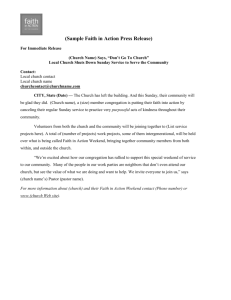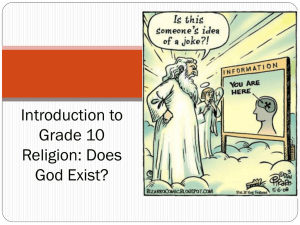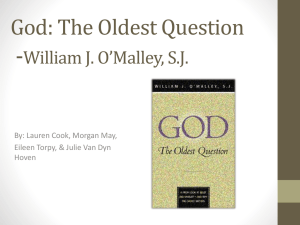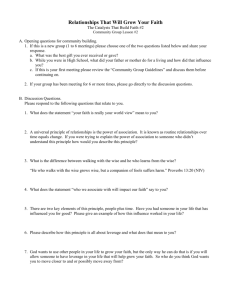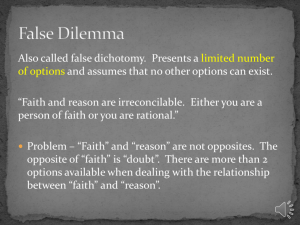File - Lifelong Faith
advertisement
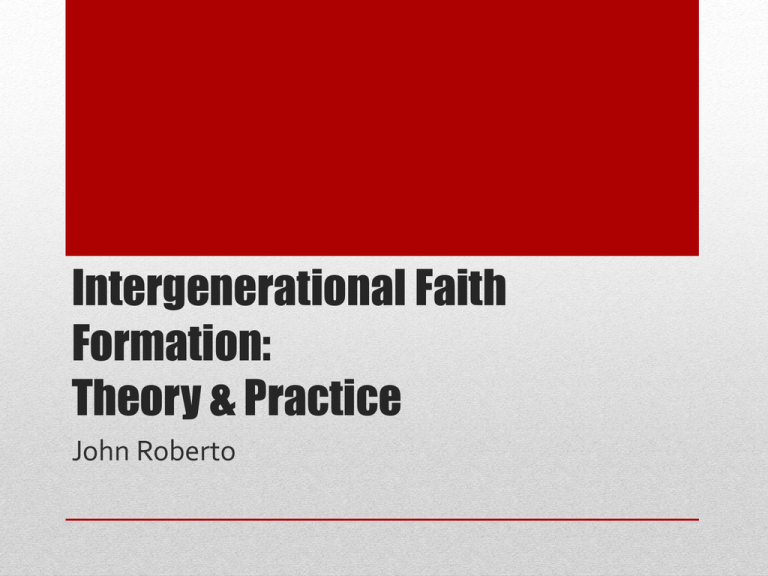
Intergenerational Faith Formation: Theory & Practice John Roberto FIRST THIRD OF LIFE Seven Faith Factors NSYR Research The combination of the following factors makes an enormous difference in religious outcomes during emerging adulthood: 1. parental religion 2. prayer 3. importance of faith 4. Scripture reading 5. having support nonparent adults in the church 6. having personal religious experiences 7. lack of religious doubts These most influential factors make differences of sizeable magnitude in substantive outcomes. Seven Faith Factors In these seven factors alone, we have identified some powerful teenage factors associated with and, we think, causing differences in emerging adult religious commitment and practice. 85% chance of being Highly Religious as an emerging adult if you were in the top 25% on the scales of: 1. parental religion 2. prayer 3. importance of faith 4. Scripture reading Seven Faith Factors 75% chance of being a Highly Religious emerging adult if you were in the the top 25% on scales of: 5. having support nonparent adults in the church, 6. having personal religious experiences 7. lack of religious doubts Seven Faith Factors “. . . teenagers with seriously religious parents are more likely that those without such parents to have been trained in their lives to think, feel, believe, and act as serious religious believers, and that that training “sticks” with them even when the leave home and enter emerging adulthood” Critical Role of Family “Emerging adults who grew up with seriously religious parents are through socialization more likely (1) to have internalized their parents religious worldview, (2) to possess the practical religious know-how needed to live more highly religious lives, and (3) to embody the identity orientations and behavioral tendencies toward continuing to practice what they have been taught religiously.” Critical Role of Family “At the heart of this social causal mechanism stands the elementary process of teaching— both formal and informal, verbal and nonverbal, oral and behavioral, intentional and unconscious, through both instruction and role modeling. We believe that one of the main ways by which empirically observed strong parental religion produced strong emerging adult religion in offspring is through the teaching involved in socialization.” (Souls in Transition: The Religious & Spiritual Lives of Emerging Adults by Christian Smith with Patricia Snell) Critical Role of Family Approximately 70% of youth who at some time or other before mid-emerging adulthood commit to live their lives for God, the vast majority appear to do so early in life, apparently before the age of 14. Most make their first commitments to God as children or during the preteen or very early teen years. Many religious trajectories followed in the course of life’s development seemed to be formed early on in life. Critical Role of Family What people have been in the past is generally the best indicator of why they are what they are in the present and what they will likely be in the future. That is a fact the needs to condition the understanding of emerging adult religion. Critical Role of Family A Faith-Forming Congregation It is the culture of the whole church that is most influential in nurturing youth of vital Christian faith. Congregational Life & Ministries Family & Household Faith Youth Ministry Congregational Leadership A Faith-Forming Congregation Congregational Faith & Qualities Congregational Leadership Qualities Youth Ministry Qualities Family & Household Faith Qualities 44 Faith Assets of Congregational Culture 1. 2. 3. 4. 5. 6. Congregation’s Biblical Emphasis Congregation Teaches Core Christian Concepts Congregation’s Moral Guidance Worship Services’ Positive Characteristics Congregation Promotes Service Congregation’s Mission Effectiveness Faith Assets: Congregational Faith 1. 2. 3. 4. 5. 6. 7. 8. Warm, Challenge Congregational Climate Welcoming Atmosphere Satisfied with the Congregation Importance of this Church to Me Congregation’s Moral Guidance Congregation’s Social Interaction Congregation’s Openness to Change Members Experience Love and Support Faith Assets: Congregational Qualities What impact did involvement in youth ministry have on young people? 1. Deepen my relationship with Jesus 2. Understand my Christian faith better 3. Apply my faith to daily life 4. Make serious life choices (future, relationships, values) 5. Share my faith These congregations are serious about making disciples of Jesus Christ. Faith Assets: Youth Ministry Retreats Peer Ministry & Youth Leadership Family & Intergenerational Activities Service & Mission Trips Bible Study & Religious Education Common YM Practices Special Events Prayer YouthOriented Worship Spiritual Support Groups Parental Faith Life & Practice Parental Help with Problems Family Harmony Parental Affection toward Children Faith Assets: Family & Household Faith of the Parents… 1. My faith helps me know right from wrong 2. I have a sense of sharing in a great purpose 3. I have had feelings of being in the presence of God 4. I have a sense of being saved in Christ 5. I am spiritually moved by the beauty of God’s creation 6. God helps me decide what is right or wrong behavior Faith Assets: Family & Household Faith Faith of the Parents… 7. 8. 9. 10. 11. I have found a way of life that gives me direction. Religious faith is important in my life. My life is committed to Jesus Christ. My life is filled with meaning and purpose. I have a real sense that God is guiding me. Each of the 11 items rate 7.30 or better on a 9.0 scale. Faith Assets: Family & Household Teens: How have your parents influenced your faith life? 1. Values are focused on serving others and God. 2. Positive influence on my religious faith 3. Talk with me about my relationship with Jesus Christ 4. Attending Sunday worship 5. Talked with my parent about religious faith 6. Reading the Bible Faith Assets: Family & Household • One in four teens said their family sat down together and talked about God, the Bible, and other religious things on a weekly or daily basis. • 40% of teens said they did this once or twice a month. Faith Assets: Family & Household Pastors matter immensely in effective youth ministry and in very specific ways. 1. Support for Christian education and youth ministry (and involvement) 2. Leadership effectiveness 3. Communication skills 4. Interpersonal characteristics 5. Support for youth staff Faith Assets: Congregational Leadership 6. Creates a healthy culture 7. Spiritual Influence (devout faith, exemplary life) 8. Personal characteristics 9. Good counselor 10. Mission is to make disciples 11. Preaches to make disciples Faith Assets: Congregational Leadership Leadership of the Youth Minister Positive Characteristics & Competence (devout faith and exemplary life, good counselor, effective model for others, helps youth on their spiritual journey) Leadership & Effectiveness (trusted and respected, recruits and trains leaders, supports leaders, good organizer, works with parents) Faith Assets: Congregational Leadership Adult Leaders in Youth Ministry People of Faith o God consciousness o Moral responsibility o Centrality of faith o Theological competence o Social responsibility Relational Characteristics o Positive relationship with youth o Positive relationship with parents Faith Assets: Congregational Leadership Sticky Faith: From High School to College 1. While most U.S. churches focus on building strong youth groups, teenagers also need to build relationships with adults of all ages. Participation in all-church worship during high school was more consistently linked with developing a mature faith in both high school and college than any other participation variable. Churches and families wanting to instill deep faith in youth should help them build a web of relationships with committed and caring adults. Sticky Faith: 3 Key Findings 2. Churches and families overestimate youth group graduates’ readiness for the struggles ahead with dire consequences for the faith. Only one in seven high school seniors report feeling prepared to face the challenges of college life with few ready for the intensity of the college experience: loneliness, the search for new friends, being completely on their own for the first time, and the sudden availability of partying. One pervasive struggle for college students is finding a new church, as evident by the 40 percent of freshman who report difficulty doing so. Young people retrospectively report that the first two weeks of their college freshman year set the trajectory for their remaining years in school. Sticky Faith: 3 Key Findings 3. While teaching young people the “dos” & “don’ts” of Christian living is important, an overemphasis on behaviors can sabotage faith long-term. When asked what it means to be Christian, one-third of subjects as college juniors (all of whom were youth group graduates) failed to mention “Jesus” or “Christ” but rather emphasized behaviors. Students tend to view the gospel as a “do” and “don’t” list of behaviors instead of a faith that also transforms interior lives and beliefs. One of the dangers of reducing Christianity to this sort of external behavior is that when students fail to live up to the activities they think define Christianity, their feelings of guilt can make them quickly abandon their faith altogether. Sticky Faith: 3 Key Findings While small groups, mentoring, justice works, and a host of other youth ministry activities are important, the reality is that the challenges of kids, ministry programs, and spiritual development are far too complicated to be met with a single solution. The closest our research has come to that definitive silver bullet is this sticky finding: high school and college students who experience more intergenerational worship tend to have higher faith maturity. We found this to be true in our studies of both high school seniors AND college freshmen. Intergenerational Relationships Intergenerational Insight #1: Involvement in all-church worship during high school is more consistently linked with mature faith in both high school and college than any other form of church participation. Intergenerational Insight #2: The more students serve and build relationships with younger children, the more likely it is that their faith will stick. Intergenerational Insights Intergenerational Insight #3: High school seniors don’t feel supported by adults in their congregations. Intergenerational Insight #4: By far, the number-one way that churches made the teens in our survey feel welcomed and valued was when adults in the congregation showed interest in them. Becoming a 5:1 Church worship, teaching, mentoring, rituals, etc. Intergenerational Insights INTERGENERATIONAL FAITH FORMATION: THEORY 1. Inclusive of all ages and generations, single or married, with or without children. 2. Builds community and meaningful relationships across all the generations in a parish. 3. Provides a setting for each generation to share and learn from the other generations. Key Features 4. Involves the whole family in learning together and equips families with the knowledge, skills, and faith-sharing activities for nurturing faith at home. 5. Provides an environment where new ways of living one’s faith can be practiced. 6. Provides adult role models for children/teens. 7. Promotes understanding of shared values and a common faith, as well as respect for individuals in all stages and ages of life. Key Features 8. Helps to overcome the age-segregated nature of our society and church programs. 9. Enhances people’s identification with their church and integration within the community. 10. Incorporates a variety of ways to learn: prayer, community building, interactive and experiential presentations and activities, group discussion and sharing. Key Features IG Parish Home Connected Faith Formation Use intergenerational learning. . . 1. As the faith formation curriculum for the whole community 2. In Lectionary-based catechesis 3. In sacramental preparation 4. In Vacation Bible School 5. In parent-child and parent-teen programs 6. In milestone celebrations 7. In intergenerational service projects 8. In liturgical season celebrations 9. In a retreat experience or parish mission Types of IG Faith Formation Families with Children Older Adults IG Faith Formation Midlife Adults Teens (and Parents) Young Adults As curriculum for parish 1. 2. 3. 4. 5. 6. 7. 8. 9. Potential Themes Church Year & Scripture Creed Sacraments Morality Justice Prayer Christian Practices Bible Mission & Ministry As curriculum for parish Christian Practices Bible Creed Sacraments Prayer Morality Justice As curriculum for parish Advent Jesus the Messiah Christmas – Epiphany Divinity of Jesus Lent Journey with Jesus Good Friday Death of Jesus Easter Season Resurrection Pentecost Mission of the Christian Sunday Readings Ministry of Jesus Sunday Readings Identity of Christ Topical Baptism Celebrations of Baptism, Baptism of the Lord, Easter Season Confirmation Eucharist Celebration of Confirmation, Pentecost Reconciliation Anointing of the Sick Marriage Lent, Reconciliation Services Orders Vocations Day Topical Sunday, First Eucharist, Holy Thursday, Corpus Christi Celebration of Sacrament, February Lectionary Readings (Cycle B) World Marriage Day, Holy Family Sunday Connecting Faith, Worship, and Life St. Elizabeth of Hungary Parish uses a liturgycentered, lifelong, and intergenerational approach to Catholic faith formation. The goal is to help and support everyone who wishes to become a better disciple by integrating faith, worship, and life in light of the Gospel. Since this is an ongoing, lifelong task, we invite EVERYONE in the parish to participate. All are welcome! Liturgical September: Mass for the 24th Sunday in Ordinary Time October: Mass for the 28th Sunday in Ordinary Time November: Mass for the 32nd Sunday in Ordinary Time December: Mass for the 2nd Sunday of Advent January: Mass for the Baptism of the Lord February: Mass for the 1st Sunday of Lent March: Mass for Palm Sunday April: Mass for the 4th Sunday of Easter May: Mass for Holy Trinity Sunday Liturgical 1. 2. 3. 4. 5. 6. 7. 8. 9. Birth / Baptism Becoming a Parent/ Grandparent Anniversary of Baptism Welcoming Young Children to Worship Entering “Sunday School” Starting School Kids and Money Blessing of the Backpacks First Communion Receiving a first Bible Milestones 10. Confirmation 11. Graduation (HS, College) 12. A New Home / Apartment 13. Career / First Job 14. Engagement 15. Wedding 16. Retirement or AARP Card 17. Transitions 18. Death / Funeral Milestones Caring for the Body Celebrating Life Discernment Dying Well Eating Well Forgiving Hospitality Keeping Sabbath Managing Household Life Participating in Community Praying Reading the Bible Transforming the World. Christian Practices INTERGENERATIONAL FAITH FORMATION: PRACTICE Meal and Community Building (30 minutes) Part 1. Gathering and Prayer (10-15) Part 2. All Ages Learning Experience (20-30) Part 3. In-Depth Learning Experience (75-90) Option 1. Whole Group (together) Option 2. Age Group (parallel) Option 3. Activity Center Part 4. Sharing Learning Experiences and Home Application (15-20) Part 5. Closing Prayer (5-10) IG Learning Process Registration & Hospitality Registration & Hospitality Registration & Hospitality Meal & Community Building Meal & Community Building Part 1. Gathering Part 2. All Ages Learning Part 2. All Ages Learning The Whole Group Format provides. . . Learning activities for everyone using small groups or table groups Intergenerational learning activities and ageappropriate learning activities for families with children, teens, young adults, and adults Lead facilitator or team guides the entire group through the learning program—giving presentations and leading activities Part 3. Whole Group Format The Age Group Format provides parallel, ageappropriate learning activities on the same theme for… 1. young children (4 and 5 year olds) 2. families with children (grades 1-5) 3. adolescents (middle school and high school) 4. young adults 5. adults Part 3. Age Group Format The Learning Activity Center Format provides. . . Learning stations or centers with structured learning activities on a common theme Age-specific or intergenerational Facilitated by leaders Part 3. Learning Center Format Part 4. Sharing & Home Application Part 4. Sharing & Home Application Closing Prayer 1. 2. 3. 4. 5. Gathering and Opening Prayer All Ages Learning: I’m Ready God, Where Are You? (Drama) In-Depth Learning: Paths of Prayer Activity 1: Creating a Space for Prayer Activity 2: Praying with Scripture Activity 3: Praying with the Psalms Activity 4: Intercessory Prayer Activity 5: The Jesus Prayer Part 4. Sharing Learning Experiences and Home Application Part 5. Closing Prayer Example: Called to Pray 1. 2. 3. 4. 5. Gathering and Opening Prayer All Ages Learning: Gospel Portraits of Jesus (multimedia experience) Age-Appropriate Learning: Exploring the Gospel Portraits of Jesus Christ • Families with Children Learning Plan • Adolescent Learning Plan • Adult Learning Plan Part 4. Sharing Learning Experiences and Home Application Part 5. Closing Prayer Example: Identity of Christ What is Jesus saying/doing? What is Jesus teaching us about the qualities of God? Activity Centers 1. Jesus is Born (Infancy Narratives) 2. Jesus Is God ‘s Beloved Son (Baptism and Transfiguration) 3. Jesus Teaches Parables of the Kingdom of God 4. Jesus Heals People 5. Jesus Forgives Sin 6. Jesus Raises People from the Dead 7. Jesus Feeds People Example: Jesus, Son of God Methods for Exploring Gospel Stories Presenting the Gospel story: proclamation, reading, media Dramatic presentations & role plays Creative art activities Storytelling & Scripture imagination activities Music Prayer and ritual Group discussion & family conversations Example: Jesus, Son of God 1. 2. 3. 4. 5. 6. 7. Jesus is Born: Creative Activity & Discussion Jesus Is God’s Beloved Son (Baptism and Transfiguration): Ritual/Prayer Activity Jesus Teaches Parables of the Kingdom of God: Rewriting Parables for Today; Creative Art Activity Jesus Heals People: Role Play/Dramatic Reading, Praying for the Sick Jesus Forgives Sin: Drama and Reflection Activity Jesus Raises People from the Dead: Dramatic Reenactment; Creative Activity Jesus Feeds People: Imagination Activity and Prayer Activity Example: Jesus, Son of God Share What Your Learning: Write a Blog Entry, Create & Share a Video or Project Family & Parents Center: How-to helps (video, audio, print) Family Faith Practices Talk About It: Conversation Questions Gathered Program Learn More: Watch a Video, Listen to a Talk, Read an Article Live: Action Project for the Month Pray Devotions, Bible Reading, Table Prayer Extend an IG Program Community & World On Your Own Mentored Face-to-Face & Virtual Church Community @Home Large Group Small Group Faith Formation Models Study It Share It Blog/Forum After Mass In Programs Family Activity Live It Taking Faith Home Insert Homily Video + Guide Daily Readings Scripture Commentaries Online Bible Study Sunday Worship Living the Message Daily Living Christian Practices Service Ideas for the Week Pray It Weekly Table Prayer Praying with the Saints AM & PM Prayer Extend Worship Resource: People of Faith 6 Volumes of IG Programs Fashioning Faith
